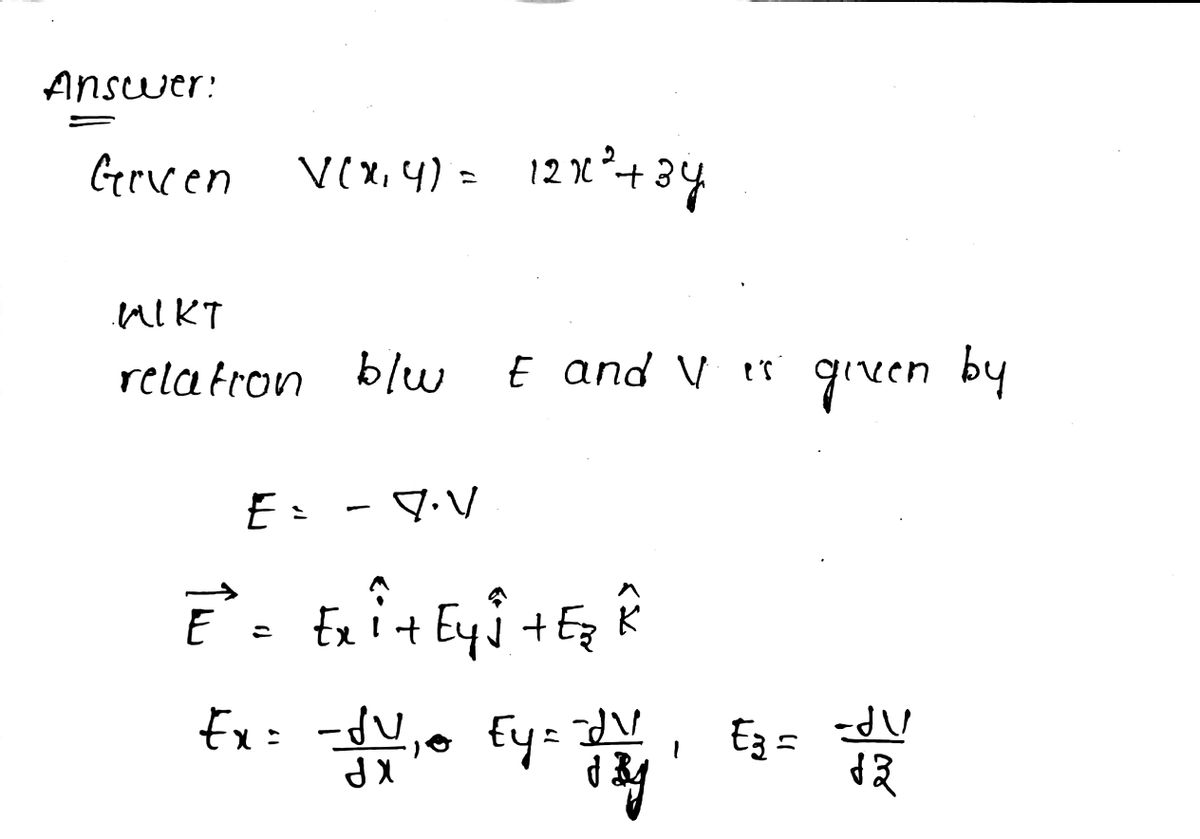
College Physics
11th Edition
ISBN: 9781305952300
Author: Raymond A. Serway, Chris Vuille
Publisher: Cengage Learning
expand_more
expand_more
format_list_bulleted
Concept explainers
Question
If the electric potential is given by V(x, y) = (12 V/m2) x2 + (3 V/m) y determine the magnitude of the electric field, in V/m, at the origin.
Expert Solution
arrow_forward
Step 1

Trending nowThis is a popular solution!
Step by stepSolved in 2 steps with 2 images

Knowledge Booster
Learn more about
Need a deep-dive on the concept behind this application? Look no further. Learn more about this topic, physics and related others by exploring similar questions and additional content below.Similar questions
- A particular dipole consists of two charges, one of charge 7.5 μC and one of -7.5 μC, spaced a distance of d = 2.3 mm apart. What is the electric potential, in V, at a perpendicular distance of y = 42 cm away from the center of the dipole?arrow_forwardThe electric potential is given by the expression V(x,y) = x2–y3where V(x, y) is in Volts and x and y are given in meters. Find the magnitude of the electric field at the point (x, y) = (2, 2).arrow_forwardIn a certain region of space there is a uniform electric field of magnitude E. What are the potential difference of: (V2 − V1); (V3 − V1); and (V4 − V1)arrow_forward
- Three charges are placed on a line with q1= 15 mC, q2 = 20 mC and q3 = -70 mC. Here d = 10 cm and h = 7 cm. Find the electric field (magnitude and direction) and the electric potential at the location of the X.arrow_forwarda) Calculate how much work is required to set up the arrangement if the charges are initially infinitely far apart and were at rest. (Hint: Use the relation between work done by external agent and total electric energy of the system) Here a = 20 cm, b= 9 cm and the three charges are gl = 28 µC, q2 = 25 µC q3 = 30 µC b) Calculate the potential at the controid(point p) of the triangle. c) Consider a spherical surface of radius r = 5a centered at p. Find the total electric flux through the surface. Total Electric Fluxarrow_forwardSuppose that the electric potential V in a certain region is given by V=Ax2−Bx+C where A=2.35 V/m2, B=4.25 V/m, and C=7.25 V. Find the magnitude of the electric field E at the point ?=1.65 m.arrow_forward
- What is the magnitude of an electric field at the point (3.00 i – 2.00 j + 4.00 k) m, if the electric potential is given by ? b V=2xyz^2arrow_forwardA point charge of q = 5.0 × 10−8 C is placed at the center of an uncharged spherical conducting shell of inner radius 6.0 cm and outer radius 9.0 cm. Find the electric potential at (a) r = 4.0 cm, (b) r = 8.0 cm, (c) r = 12.0 cm.arrow_forwardThe electric potential at x = 3.00 m is 120 V, and the electric potential at x = 5.00 m is 190 V. What is the x component of the electric field in this region, assuming the field is uniform? (a) 140 N/C (b) 2140 N/C (c) 35.0 N/C (d) 235.0 N/C (e) 75.0 N/Carrow_forward
- Which of the following statements is true about the magnitude of the net electric field E and the net electric potential V, at the center of the square as shown below?Which of the following statements is true about the magnitude of the net electric field E and the net electric potential V, at the center of the square as shown below? E = 0; V ≠ 0 E ≠ 0; V = 0 E = 0; V = 0 E ≠ 0; V ≠ 0arrow_forward(a) The electric potential in a region is given by the equation V(x, y) = (1.00) xyz +2.00v. sin (3.00-x). What is the force on a 65.4 mC located at position (3.30 m, 4.21 m,-1.80 m)? Give your answer in vector component notation. (b) The electric potential in a region is given by the equation V(x, y, z) = (2.40)x²y + (1.5 V)e (1.002). What is the force on a 12.6 mC located at position (-1.30 m, 2.48 m,-2.10 m)? Give your answer in vector component notation.arrow_forwardWhat is the magnitude of the electric field at the point (8.10i - 5.80j+9.40 k) m if the electric potential is given by V= 8.50xyz?, where Vis in volts and x, y, and z are in meters?arrow_forward
arrow_back_ios
SEE MORE QUESTIONS
arrow_forward_ios
Recommended textbooks for you
 College PhysicsPhysicsISBN:9781305952300Author:Raymond A. Serway, Chris VuillePublisher:Cengage Learning
College PhysicsPhysicsISBN:9781305952300Author:Raymond A. Serway, Chris VuillePublisher:Cengage Learning University Physics (14th Edition)PhysicsISBN:9780133969290Author:Hugh D. Young, Roger A. FreedmanPublisher:PEARSON
University Physics (14th Edition)PhysicsISBN:9780133969290Author:Hugh D. Young, Roger A. FreedmanPublisher:PEARSON Introduction To Quantum MechanicsPhysicsISBN:9781107189638Author:Griffiths, David J., Schroeter, Darrell F.Publisher:Cambridge University Press
Introduction To Quantum MechanicsPhysicsISBN:9781107189638Author:Griffiths, David J., Schroeter, Darrell F.Publisher:Cambridge University Press Physics for Scientists and EngineersPhysicsISBN:9781337553278Author:Raymond A. Serway, John W. JewettPublisher:Cengage Learning
Physics for Scientists and EngineersPhysicsISBN:9781337553278Author:Raymond A. Serway, John W. JewettPublisher:Cengage Learning Lecture- Tutorials for Introductory AstronomyPhysicsISBN:9780321820464Author:Edward E. Prather, Tim P. Slater, Jeff P. Adams, Gina BrissendenPublisher:Addison-Wesley
Lecture- Tutorials for Introductory AstronomyPhysicsISBN:9780321820464Author:Edward E. Prather, Tim P. Slater, Jeff P. Adams, Gina BrissendenPublisher:Addison-Wesley College Physics: A Strategic Approach (4th Editio...PhysicsISBN:9780134609034Author:Randall D. Knight (Professor Emeritus), Brian Jones, Stuart FieldPublisher:PEARSON
College Physics: A Strategic Approach (4th Editio...PhysicsISBN:9780134609034Author:Randall D. Knight (Professor Emeritus), Brian Jones, Stuart FieldPublisher:PEARSON

College Physics
Physics
ISBN:9781305952300
Author:Raymond A. Serway, Chris Vuille
Publisher:Cengage Learning

University Physics (14th Edition)
Physics
ISBN:9780133969290
Author:Hugh D. Young, Roger A. Freedman
Publisher:PEARSON

Introduction To Quantum Mechanics
Physics
ISBN:9781107189638
Author:Griffiths, David J., Schroeter, Darrell F.
Publisher:Cambridge University Press

Physics for Scientists and Engineers
Physics
ISBN:9781337553278
Author:Raymond A. Serway, John W. Jewett
Publisher:Cengage Learning

Lecture- Tutorials for Introductory Astronomy
Physics
ISBN:9780321820464
Author:Edward E. Prather, Tim P. Slater, Jeff P. Adams, Gina Brissenden
Publisher:Addison-Wesley

College Physics: A Strategic Approach (4th Editio...
Physics
ISBN:9780134609034
Author:Randall D. Knight (Professor Emeritus), Brian Jones, Stuart Field
Publisher:PEARSON